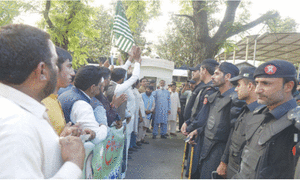In a densely populated part of the city stands a 104-year-old building, now the Government Postgraduate College Asghar Mall, which bears the marks of the historical pluralism of Rawalpindi.
Established by the Sanatan Dharma, a Hindu religious movement, in 1904, the site was first home to a religious school in front of the Khalsa High School, which was run by Sikhs, and aimed to teach students from all religious backgrounds. The current building was constructed in 1913 and named Sanatan Dharma High School.
In 1948, the building became the first government-run college in the Rawalpindi division. The Government Gordon College, which was established in 1901, remained a private school in the Potohar region until 1972.

“Sanatan Dharma was a Hindu religious movement that opened many schools and colleges in Rawalpindi and other parts of India,” explained Jag Mohan Arora of the All Pakistan Hindu Sikh Welfare Association.
Fast bowler Shoaib Akhtar, actor Mohammad Afzal – who is also known as Rambo, MNA Malik Abrar, MPA Raja Hanif, Dr Jamal Nasir, former law minister Babar Awan, the deputy inspector general of the Punjab Police Chaudhry Azhar, Naseer Ahmed and many other notable figures studied at this college.
The building is a mix of Mughal and British architecture. There was also a Hindu temple adjacent to the college, which teachers and alumni said was a part of the college campus.

The college walls are also engraved with the Star of David, a symbol of Judaism, reflecting the role of the Jewish community in making the building, while a crucifix can be seen on the main building.
The building was constructed using donations from various members of the society and from diverse religious groups, including Hindus, Sikhs and Muslims. In the college hostel, there are plaques bearing the names of Hindu philanthropists. Some of the rooms were built by Lala Peshawari, in memory of his father Lala Haran Das, while some were built by Saith Ram Gopal and Jevan Devi, in memory of her husband Lala Pindi Das.
The college’s main building, however, needs attention from the government to repair broken windows and doors.
“Hindu religious symbols were also on the walls and the roof, but after the destruction of the Babri Mosque in 1992, protesters erased these symbols,” Prof Khushi Mohammad Nasir, the principal of the college, recalled.

He said a crescent, a crucifix and Sikh religious symbols were also engraved on the walls. “The Hindu temple is not yet part of the college premises, but old timers think it was located in the sports ground,” he added.
“In 1948, the school was turned into an intermediate college and then upgraded to degree level. In 1963, it was upgraded to postgraduate level, and in 1972 two more masters programmes were added so now the college offers six postgraduate courses: Urdu, English, Mathematics, Economics, Geography and Physics,” he said.
He said the college has over 2,300 students, some of whom have won gold medals in various curricular and extracurricular activities.
Published in Dawn, April 2nd, 2017













































